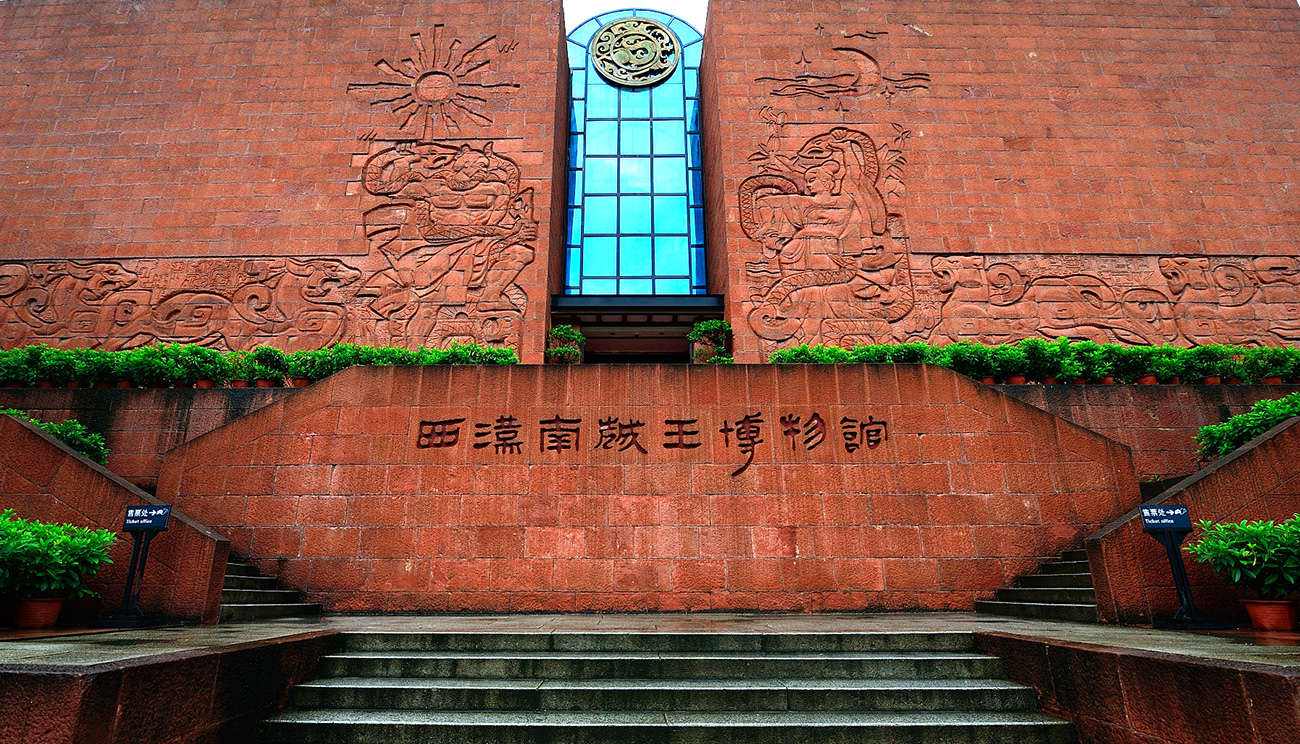1. Canton Tower:Canton Tower is a new landmark in Guangzhou, 600 meters above sea level, is the highest tower in China, because of its unique appearance is known as "small waist", the narrowest part of the tower is only 30 meters wide. The main attractions are the Spiderman walkway, Ferris wheel, downhill seats, 454-meter outdoor observation deck, revolving restaurant and so on.
广州塔为广州新地标,海拔600米,是国内第一高塔,因其独特的外型被人们称为“小蛮腰”,塔身最细处仅有30米宽。主要景点有蜘蛛侠栈道、摩天轮、速降座椅、454米户外观景台,旋转餐厅等。
2. Pearl River Night Cruise:The Pearl River Night Cruise covers the golden waters from Canton Tower to Pearl River. When tourists get onboard of the boat, they can view the scenery when recalling Guangzhou’s history as well as its rapid development in current years, as if Guangzhou’s thousand-year history slowly unfolds in front of their eyes, as the breeze seems to be telling anecdotes of the golden age. Tourists may appreciate the courage and charm of Guangzhou as a national central city and commercial capital with a history of thousands of years.
珠江夜游航线覆盖从广州塔到珠江的黄金水域。游客登船后,可以一边欣赏美景,一边回顾广州的历史以及近年来的快速发展,仿佛广州千年的历史在眼前缓缓展开,微风似乎在诉说着黄金时代的故事。游客可以感受到广州作为国家中心城市和商业之都的勇气与魅力。

3. Shamian Island, located in Liwan District of Guangzhou, is a historically significant area known for its colonial architecture and picturesque setting along the Pearl River. Once a concession shared by the British and French during the 19th century, the island served as a trading hub and diplomatic enclave. Its well-preserved European-style buildings, tree-lined boulevards, and tranquil atmosphere make it a popular destination for both tourists and locals. Today, Shamian Island offers a glimpse into Guangzhou's colonial past while blending seamlessly with the city's modern vibrancy.
沙面岛位于广州荔湾区,是一个历史悠久的地区,以其殖民地建筑和珠江沿岸的美丽风光闻名。19世纪时,沙面曾是英法共管的租界,作为贸易中心和外交使馆区。岛上保留完好的欧式建筑、林荫大道以及宁静的氛围,使其成为游客和当地人喜爱的景点。如今,沙面岛既展现了广州的殖民历史,又与这座现代化城市的活力完美融合。

4. The Guangdong Provincial Museum, located in Zhujiang New Town, Guangzhou, is a major cultural institution showcasing the rich history, art, and natural heritage of Guangdong Province. Established in 1959 and housed in a striking modern building, the museum features a wide range of exhibits, including ancient artifacts, traditional ceramics, calligraphy, and relics of Lingnan culture. It also has a comprehensive natural history section, highlighting the region’s diverse flora and fauna. As one of the leading museums in southern China, it serves as a key destination for both cultural education and tourism.
广东省博物馆位于广州市珠江新城,是展示广东省丰富历史、艺术和自然遗产的重要文化机构。博物馆成立于1959年,现坐落于一座现代化的标志性建筑内,展品涵盖古代文物、传统陶瓷、书法及岭南文化遗存等多个方面。博物馆还设有综合自然历史展区,展示了该地区多样的动植物资源。作为华南地区领先的博物馆之一,广东省博物馆是文化教育与旅游的重要目的地。

5. The Museum of the Western Han Dynasty Mausoleum of the Nanyue King, located in Yuexiu District, Guangzhou, houses the 2,000-year-old tomb of the Nanyue King Zhao Mo, a ruler of the Nanyue Kingdom during the Western Han Dynasty. Discovered in 1983, the museum displays an extensive collection of artifacts from the tomb, including a jade burial suit, bronze vessels, and other precious relics that reflect the cultural and political significance of the era. The museum offers a fascinating glimpse into the life and legacy of the Nanyue Kingdom, making it a vital destination for those interested in ancient Chinese history and archaeology.
西汉南越王博物馆位于广州越秀区,馆内保存着距今2000多年的南越王赵眜的陵墓,他是西汉时期南越国的君主。陵墓于1983年被发现,博物馆展出了大量出土文物,包括玉衣、青铜器以及其他珍贵遗物,展现了该时期的文化和政治重要性。博物馆为参观者提供了深入了解南越国历史与遗产的机会,是古代中国历史与考古学爱好者的重要参观地点。
6. Chen Clan Ancestral Hall, located in Liwan District, Guangzhou, is a renowned cultural and architectural landmark built during the late Qing Dynasty (1890). Initially constructed as a place for the Chen family to honor their ancestors, it now serves as a museum showcasing traditional Cantonese culture and art. The hall features exquisite carvings, intricate pottery, and stunning paintings that reflect the craftsmanship of the era. With its distinctive architectural style, combining elements of traditional Chinese design and Western influences, the hall stands as a testament to the rich heritage of the Chen clan and the broader Guangdong region. It is a popular destination for both tourists and locals seeking to appreciate the cultural significance of this historical site.
陈家祠位于广州市荔湾区,是一座著名的文化和建筑地标,建于清朝晚期(1890年)。最初建造时作为陈氏家族祭祖的场所,如今已成为展示传统粤文化和艺术的博物馆。陈家祠内雕刻精美、陶瓷精致、绘画惊艳,反映了当时的工艺水平。该祠堂具有独特的建筑风格,融合了传统中国设计和西方影响,是陈氏家族及更广泛的广东地区丰富遗产的见证。它是游客和当地人欣赏这一历史遗址文化意义的热门目的地。

7. Yongqing Fang, located in the heart of old Guangzhou, is a historic residential complex that exemplifies traditional Lingnan architecture. Originally built in the late Qing Dynasty, this well-preserved site features charming courtyards, intricately carved wooden structures, and vibrant tiles, reflecting the unique cultural heritage of the region. Yongqing Fang has been revitalized as a cultural and commercial hub, offering visitors a glimpse into the local lifestyle through its boutiques, cafes, and artisan shops. The complex serves not only as a tourist attraction but also as a space for cultural events and exhibitions, making it a lively center for both locals and visitors to explore Guangzhou's rich history and contemporary creativity.
永庆坊为中国广东广州一个南北走向的内街创意园区,位于荔湾区恩洲社区一带,南起恩宁路,北至荔枝湾涌与粤剧艺术博物馆附近。永庆坊体现传统岭南建筑风格的历史住宅综合体。该建筑群最初建于清朝晚期,保存完好,拥有迷人的庭院、精美的木结构和生动的瓷砖,反映了该地区独特的文化遗产。永庆坊经过 revitalization(复兴)成为一个文化和商业中心,游客可以通过这里的商店、咖啡馆和手工艺品店一窥当地生活方式。这个综合体不仅是旅游景点,也是文化活动和展览的场所,使其成为本地人和游客探索广州丰富历史与当代创意的活力中心。

8. Baiyun Mountain, is a popular natural landmark in Guangzhou, China. Known for its beautiful landscapes, the mountain features lush greenery, scenic trails, and diverse flora and fauna. Its name comes from the mist that often shrouds its peaks, creating a serene atmosphere. Baiyun Shan offers various viewpoints, temples, and recreational areas, making it a favorite spot for hikers and nature lovers seeking a peaceful escape from the city. As a key attraction, it symbolizes the harmony between nature and urban life in Guangzhou.
白云山是新“羊城八景”之一,登上主峰摩星岭可俯览全市,遥望珠江,山间白云缭绕,白云山之名由此得来,它不仅是市民休闲健身的好去处,更是调节城市生态环境的“天然大氧吧”被喻为广州“市肺”。白云山风景区有摩星岭景区、明珠楼景区、飞鹅岭景区等7个游览区。

